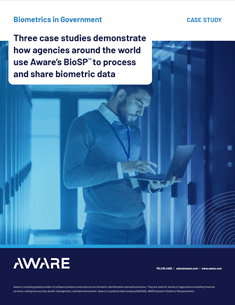Infographic
Biometrics-as-a-Service (BaaS) solutions from Aware are an attractive alternative to traditional biometric software models. This technology allows organizations of all types – from governments to telecommunications companies – to quickly deploy and start using biometrics technology in their day-to-day identity management operations.
In other words, with BaaS, you can start practicing fingerprint scanning and facial recognition to enroll employees and customers, thereby combating fraud and streamlining customer service, without costly, time-consuming and resource-intensive software acquisition and integration processes.
Here’s how it works: Aware hosts a biometrics platform in the cloud that has all the functions needed to integrate facial recognition, fingerprint scanning and other biometric identification processes into your onboarding and identity management operations. Aware’s BaaS solution is delivered either through a subscription model or server-based software license, and it is accessible via the internet through a web browser.
The introduction of this service comes at a perfect time, as the need for a cloud-based biometrics search and enrollment platform continues to rise: The global BaaS market is growing 17.11 percent year over year through 2020, largely due to demand for mobile biometrics, according to Research and Markets.
Let’s dive deeper into the BaaS model to understand the benefits and use cases.
The Advantages of BaaS
One of the greatest benefits of BaaS is that your organization acquires biometrics search and enroll capabilities without having to build those systems yourself. You don’t have to manage the biometric information, either – the BaaS provider handles that for you.
Enrolling employees, customers or business partners in the identification system is pretty easy. Essentially, you can pull up an internet browser on computer connected to a biometrics-capturing device (and not just hardware created specifically for these purposes but also including Android tablets and smartphones) to take fingerprint scans. To capture facial recognition records, simply use a digital camera in the same manner.
Once you’ve enrolled an employee or a customer, all of your locations (assuming they have devices that can collect biometrics information) can confirm people’s identities via an internet connection to cloud-based databases containing biometrics information.
As a result of being able to quickly search and compare employees’ and customers’ fingerprints and faces, your organization can combat fraud and improve customer service.
How Can You Use BaaS?
In some parts of the world – Nigeria, for instance – criminals purchase and re-sell SIM cards to people who want to use mobile technology for the purpose of orchestrating kidnappings, internet banking fraud and other major crimes, such as terrorism. According to International Business Times, the Nigerian Communications Commission deactivated 10.7 million unregistered SIM cards in order to deter criminal and terrorist activity.
Biometric registration eliminates the anonymity associated with buying SIM cards. Every time someone wants to buy a SIM card, he or she has to register his fingerprint with the telecom. That means, if a SIM owner tries to use the associated number to coordinate a robbery or some other criminal activity, authorities will know his or her identity.
As a whole, BaaS is a critical asset for those in charge of know-your-customer efforts. Suppose a criminal tries to open a bank account in an existing customer’s name. Upon scanning the fraudster’s fingerprints, the onboarding system recognizes that the criminal isn’t who he claims to be. Thus, the customer service representative terminates the transaction.
BaaS can also aid authorities at the voting booths. In places where voter fraud is common, officials can create virtual citizen IDs using people’s fingerprints and facial images. The ensures that the same person can’t vote twice. In addition, it eliminates the possibility of someone committing ballot stuffing, as voting occurs electronically.
There are numerous ways in which the banking industry can utilize BaaS. For example, suppose a customer has another account in a separate country. He asks you to ensure that only he can transfer money between his domestic and foreign account. To meet this request, you could require a fingerprint scan for every transfer request – no matter if he does it at a branch or online.
Overall, BaaS provides you with the means to verify the identities of whoever you wish, without having to build up the infrastructure necessary to do so. You don’t have to worry about databases, biometric recognition code, or any of that – it’s all delivered to you over an internet connection.

